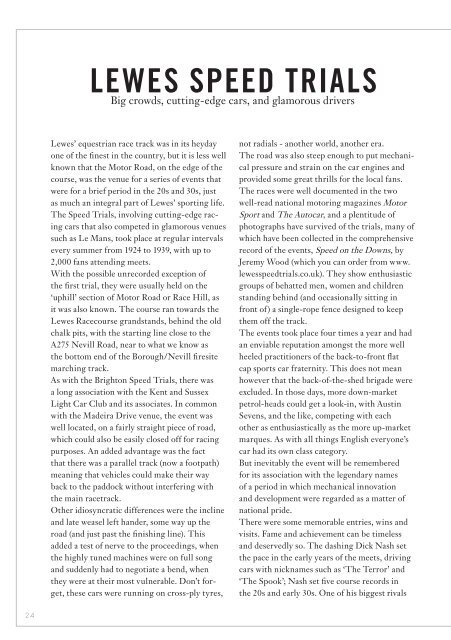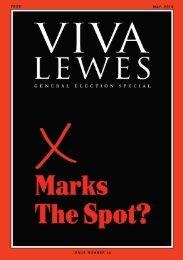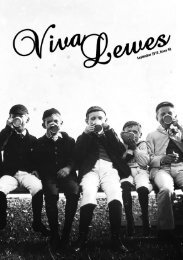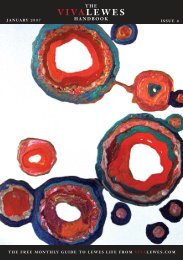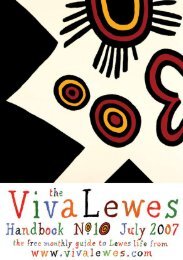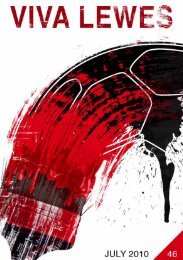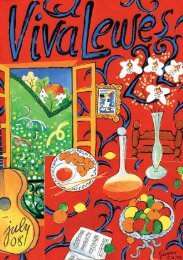You also want an ePaper? Increase the reach of your titles
YUMPU automatically turns print PDFs into web optimized ePapers that Google loves.
2 4<br />
lewes speed trials<br />
Big crowds, cutting-edge cars, and glamorous drivers<br />
<strong>Lewes</strong>’ equestrian race track was in its heyday<br />
one of the finest in the country, but it is less well<br />
known that the Motor Road, on the edge of the<br />
course, was the venue for a series of events that<br />
were for a brief period in the 20s and 30s, just<br />
as much an integral part of <strong>Lewes</strong>’ sporting life.<br />
The Speed Trials, involving cutting-edge racing<br />
cars that also competed in glamorous venues<br />
such as Le Mans, took place at regular intervals<br />
every summer from 1924 to 1939, with up to<br />
2,000 fans attending meets.<br />
With the possible unrecorded exception of<br />
the first trial, they were usually held on the<br />
‘uphill’ section of Motor Road or Race Hill, as<br />
it was also known. The course ran towards the<br />
<strong>Lewes</strong> Racecourse grandstands, behind the old<br />
chalk pits, with the starting line close to the<br />
A275 Nevill Road, near to what we know as<br />
the bottom end of the Borough/Nevill firesite<br />
marching track.<br />
As with the Brighton Speed Trials, there was<br />
a long association with the Kent and Sussex<br />
Light Car Club and its associates. In common<br />
with the Madeira Drive venue, the event was<br />
well located, on a fairly straight piece of road,<br />
which could also be easily closed off for racing<br />
purposes. An added advantage was the fact<br />
that there was a parallel track (now a footpath)<br />
meaning that vehicles could make their way<br />
back to the paddock without interfering with<br />
the main racetrack.<br />
Other idiosyncratic differences were the incline<br />
and late weasel left hander, some way up the<br />
road (and just past the finishing line). This<br />
added a test of nerve to the proceedings, when<br />
the highly tuned machines were on full song<br />
and suddenly had to negotiate a bend, when<br />
they were at their most vulnerable. Don’t forget,<br />
these cars were running on cross-ply tyres,<br />
not radials - another world, another era.<br />
The road was also steep enough to put mechanical<br />
pressure and strain on the car engines and<br />
provided some great thrills for the local fans.<br />
The races were well documented in the two<br />
well-read national motoring magazines Motor<br />
Sport and The Autocar, and a plentitude of<br />
photographs have survived of the trials, many of<br />
which have been collected in the comprehensive<br />
record of the events, Speed on the Downs, by<br />
Jeremy Wood (which you can order from www.<br />
lewesspeedtrials.co.uk). They show enthusiastic<br />
groups of behatted men, women and children<br />
standing behind (and occasionally sitting in<br />
front of) a single-rope fence designed to keep<br />
them off the track.<br />
The events took place four times a year and had<br />
an enviable reputation amongst the more well<br />
heeled practitioners of the back-to-front flat<br />
cap sports car fraternity. This does not mean<br />
however that the back-of-the-shed brigade were<br />
excluded. In those days, more down-market<br />
petrol-heads could get a look-in, with Austin<br />
Sevens, and the like, competing with each<br />
other as enthusiastically as the more up-market<br />
marques. As with all things English everyone’s<br />
car had its own class category.<br />
But inevitably the event will be remembered<br />
for its association with the legendary names<br />
of a period in which mechanical innovation<br />
and development were regarded as a matter of<br />
national pride.<br />
There were some memorable entries, wins and<br />
visits. Fame and achievement can be timeless<br />
and deservedly so. The dashing Dick Nash set<br />
the pace in the early years of the meets, driving<br />
cars with nicknames such as ‘The Terror’ and<br />
‘The Spook’; Nash set five course records in<br />
the 20s and early 30s. One of his biggest rivals


